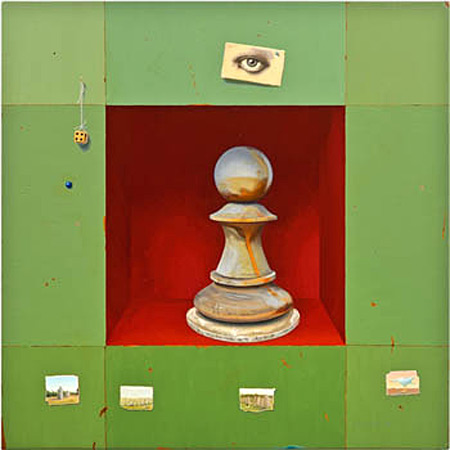
Continuing through April 13, 2013
Ron Rizk's exquisitely rendered and irreverent still-life paintings continue to bemuse and amaze. Adding a contemporary twist to American trompe l'oeil painting in the best tradition of William Harnett and John Frederick Peto, Rizk's delicate images of antique toys, duck decoys, fishing lures, chess pieces and telephones have a wry sensibility and an ironic edge. Like his predecessors, he recreates objects that are familiar yet worn, like the old red telephone or the vintage carved animal, with the intent of jarring our comfort zone when we realize the illusion.
Each object plays a part in the painterly tableau that Rizk arranges, with a shadow box as the main compositional component. The drama plays out suggestively: an old red telephone, with its receiver off the hook, is surrounded by a question mark and exclamation points in "Talk." The crimson phone vibrates against the royal blue walls and vivid green enclosure of the shadow box.
Whimsy is the order of the day in "Along the Mohawk," where faceted and colorful arrowheads dance against the horizon line, their shapes emulating trees. One arrowhead even launches into the sky like a rocket. Broken and torn Delft tiles are rearranged and manipulated in "Dutch Fragments," where porcelain bits float in an apricot colored rectangle over a background of clouds and a geometric patterned floor worthy of René Magritte.
While depicting real objects with great dexterity, Rizk's paintings have an element of playful surrealism that is subtly revealed as you look. A toy vehicle out of Flash Gordon's comic book world is the focus in "Flash," with stylized lightning drawing attention to the backdrop; the distance between reality and fantasy is never far apart.
Bird decoys abound in the paintings, whether ducks caught in a duck blind for hunters, or decoys placed in odd groupings, as in “Rise and Fall.” In “Riverview” the wooden fowl occupies the foreground for a encapsulated piece of bucolic scenery. The decoys are a perfect foil for Rizk: they are fakes placed in a flat picture plane. Various fishing accouterments also appear, a tin of fish and a fishing lure in “Caviar;” shimmering weights and lines are balanced precariously in the appropriately titled “Tension.” In “Tin Fish” the silver lure is surrounded by various flattened species of fish like a natural history display.
A chess piece stained with paint transforms into an ominous monument as it is given center stage in “Monolith.” A beautifully rendered eye that floats above the chess piece on a scrap of paper and a die that hangs from a string increases the mystery. Rizk's layers of illusion are skillfully sandwiched between layers of reality so as to keep us guessing. The artificiality of the fishing and hunting lures are exposed as nature fluctuates between the real and the fake. While using vintage objects that convey familiarity, sport and comfort, Rizk places them in eerie groupings that tweak reality. He creates rebuses that tantalize but resist deciphering.
